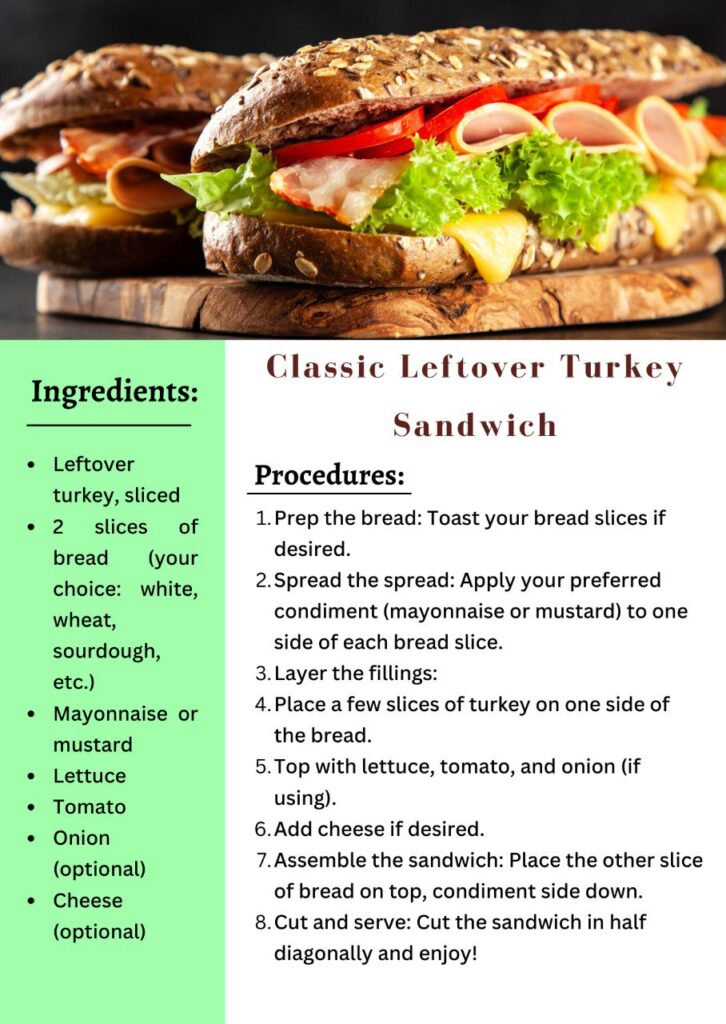While the traditional Thanksgiving spread can be a feast for the eyes and the stomach, it doesn’t have to break the bank. This year, let’s reimagine the classic Thanksgiving turkey dinner, turning it into a budget-friendly masterpiece that’s just as delicious and heartwarming.
Join us as we dive into the art of how to cook Thanksgiving turkey on a budget without sacrificing flavor or quality. From selecting the right bird to mastering the art of roasting, we’ll guide you through every step, ensuring a stress-free and affordable Thanksgiving feast.
So, gather your loved ones, roll up your sleeves, and let’s create a memorable Thanksgiving, one bite at a time.
Planning and Preparation: Choosing the Right Turkey
The heart of any Thanksgiving feast is undoubtedly the turkey. To ensure a delicious and cost-effective centerpiece, careful planning and preparation are key.
- Guest Count: The first step is to determine the ideal size of your turkey. A general rule of thumb is to plan for one pound of turkey per person, or one and a half pounds per person if you anticipate leftovers.
- Fresh or Frozen: Consider your timeline and budget when deciding between a fresh or frozen turkey. Frozen turkeys often offer better deals and can be stored for longer periods.
- Smart Shopping: Keep an eye out for sales and discounts, especially as Thanksgiving approaches. Many grocery stores and supermarkets offer significant savings on turkeys during the holiday season. You can go with the more affordable skinless male turkey breasts.
According to Kroger, “In most homes, Thanksgiving is a chance to bring out our favorite family recipes, ones we’ve been looking forward to all year long. This makes planning and budgeting ahead simple. Create your menu in advance so that you can grab ingredients when they’re on sale. Shopping gradually will also help relieve some of the stress leading up to the holiday.”
A Flavorful and Affordable Thanksgiving Turkey
Once you’ve selected your perfect turkey, it’s time to turn your attention to the cooking method. For a budget-friendly and delicious Thanksgiving turkey, consider these simple yet effective tips:
- A No-Frills Approach: Opt for a straightforward recipe that doesn’t require elaborate techniques like brining or frequent basting. These methods can be time-consuming and may not significantly impact the final flavor.
- Slow and Steady Wins the Race: A slow-cooking method, such as roasting at a lower temperature, can help ensure a moist and tender turkey. This technique also allows for more even cooking and reduces the risk of drying out the bird.
- Herbs and Aromatics: Elevate your turkey’s flavor profile without breaking the bank by using readily available herbs and aromatics. Fresh herbs like rosemary, thyme, and sage, along with simple spices like black pepper and paprika, can add depth and complexity to your dish.
Thawing and Preparing the Turkey
Before you embark on your culinary journey, it’s essential to properly thaw and prepare your turkey. Here’s a step-by-step guide:
Thawing Your Turkey
– Refrigerator Thawing: This is the safest method. Plan ahead, as it takes approximately 24 hours to thaw 4-5 pounds of fresh turkey in the refrigerator. Place the turkey on a large, rimmed baking sheet to catch any drips and store it on the bottom shelf of your refrigerator.
– Cold Water Thawing: If you’re short on time, you can thaw your turkey in cold water. Submerge the wrapped turkey in a large, clean sink filled with cold water. Change the water every 30 minutes until the turkey is completely thawed. Cook the turkey immediately after thawing.
Preparing the Turkey
– Remove the Innards: Once thawed, carefully remove the giblets (liver, heart, and gizzard) and neck from the turkey cavity. These can be saved for making gravy or discarded.
– Pat Dry: Use paper towels to gently pat the thawed turkey dry, both inside and out. This helps to achieve a crispy skin and promotes even browning.
Cooking the Turkey
Once your turkey is thawed and prepped, it’s time to do the roast aspect of your roast turkey recipe. Here’s a simple and effective method to cook a turkey:
Prepping for Roasting
1. Preheat Your Oven: Set your oven to 350°F (175°C) to ensure a consistent cooking temperature.
2. Choose Your Roasting Pan: Select a roasting pan that’s large enough to accommodate your turkey comfortably. A roasting rack placed inside the pan will help air circulate around the bird, promoting even cooking.
3. Add Aromatics: Before placing the turkey in the pan, add some aromatic vegetables like onions, carrots, and celery. These vegetables will add flavor to the drippings, which you can later use to make a delicious gravy.
Roasting Your Turkey
4. Place the Turkey: Carefully position the turkey breast-side up in the roasting pan for a perfectly-cooked turkey.
5. Roasting Time: The general rule of thumb is to allow 13-15 minutes per pound of turkey for a 350°F oven. However, the best way to determine doneness is to use a meat thermometer. Insert the thermometer into the thickest part of the thigh, avoiding bone, and cook until it reaches an internal temperature of 165°F (74°C).
Tips for a Moist and Delicious Turkey
To ensure a moist and delicious Thanksgiving turkey, follow these helpful tips:
1. Temperature Matters
Invest in a reliable meat thermometer to accurately monitor the internal temperature of your turkey. As mentioned earlier, aim for an internal temperature of 165°F (74°C) in the thickest part of the thigh. Overcooking can lead to a dry and tough bird.
2. Resting is Key
Once your turkey reaches the desired temperature, resist the urge to carve it immediately. Allow it to rest for at least 30 minutes, preferably covered loosely with foil. This resting period allows the juices to redistribute throughout the meat, resulting in a more tender, flavorful, and juicy turkey.
3. Herb Butter Magic
Elevate your turkey’s flavor by using a flavorful herb butter. Simply combine softened butter with fresh herbs like rosemary, thyme, and sage, along with garlic and lemon zest. Spread the herb butter under the skin of the moist turkey before roasting for a burst of flavor and added moisture.
Alternative Main Course Options
While a traditional roasted turkey is a classic Thanksgiving centerpiece, there are plenty of other delicious and affordable options to consider. Here are a few ideas:
Poultry Alternatives
- Rotisserie Chicken: A convenient and cost-effective choice, a rotisserie chicken can be the star of your Thanksgiving meal. Simply reheat it in the oven and serve with your favorite side dishes.
- Cornish Game Hens: Smaller than a full-sized turkey, Cornish game hens are perfect for smaller gatherings or as an alternative to a whole bird. They cook quickly and are easy to prepare.
Vegetarian Options
- Roasted Cauliflower: A hearty and satisfying vegetarian main course, roasted cauliflower can be dressed up with herbs, spices, and a flavorful sauce.
- Tofu Roast: A versatile protein source, tofu can be marinated and roasted to create a delicious and nutritious main dish.
- Vegetarian Casserole: A comforting and cheesy option, a vegetarian casserole dish with roasted vegetables, tofu, and a creamy sauce is a great choice.
Turkey Alternatives
- Turkey Breasts: If you’re feeding a smaller crowd, consider cooking turkey breasts. They cook more quickly than a whole turkey and are easier to carve.
- Turkey Legs or Thighs: These dark meat cuts are more flavorful and tend to be more affordable than turkey breasts. They’re perfect for a smaller, more intimate gathering.
According to Ent Credit Union, “One of the most effective strategies to host a Thanksgiving dinner on a budget is to take full advantage of sales and coupons. Retailers often offer significant discounts on popular holiday items in the period leading up to Thanksgiving. By being proactive, you can secure the best deals.”
Carving and Serving
Once your turkey has rested, it’s time to carve and serve this delicious centerpiece. Here are some tips to ensure a smooth and successful carving process:
Carving Your Turkey
– Use Sharp Tools: A sharp carving knife and a sturdy carving fork are essential for precise cuts. Dull knives can make the process difficult and increase the risk of tearing the meat.
– Start with the Legs and Thighs: Begin by removing the legs and thighs from the turkey. Use your fork to hold the leg steady and carve the meat away from the bone.
– Carve the Breast: Once the legs and thighs are removed, you can carve the breast meat. Use your knife to make shallow cuts along the bone, then slice the meat across the grain.
Serving Your Turkey
– Gravy, Gravy, Gravy: A rich and flavorful gravy is the perfect accompaniment to your Thanksgiving turkey. Use the pan drippings from the roasting pan to make a delicious gravy.
– Classic Side Dishes: Complete your Thanksgiving feast with a variety of classic side dishes, such as mashed potatoes, stuffing, and cranberry sauce.
– Creative Side Dishes: If you’re looking to add a unique twist to your Thanksgiving meal, consider trying some creative side dishes, such as roasted Brussels sprouts with bacon or sweet potato casserole with marshmallows.
Making the Most of Your Thanksgiving Turkey Recipe
One of the best things about Thanksgiving is the delicious leftovers. With a little creativity, you can transform your leftover turkey into a variety of meals throughout the week.
Here are some ideas for the best Thanksgiving turkey recipe:
Classic Leftover Turkey Sandwich

Ingredients:
- Leftover turkey, sliced
- 2 slices of bread (your choice: white, wheat, sourdough, etc.)
- Mayonnaise or mustard
- Lettuce
- Tomato
- Onion (optional)
- Cheese (optional)
Instructions:
- Prep the bread: Toast your bread slices if desired.
- Spread the spread: Apply your preferred condiment (mayonnaise or mustard) to one side of each bread slice.
- Layer the fillings:
- Place a few slices of turkey on one side of the bread.
- Top with lettuce, tomato, and onion (if using).
- Add cheese if desired.
- Assemble the sandwich: Place the other slice of bread on top, condiment side down.
- Cut and serve: Cut the sandwich in half diagonally and enjoy!
Tips:
- Elevate your sandwich: Add a dollop of cranberry sauce or a drizzle of gravy for a festive twist.
- Get creative with flavors: Experiment with different cheeses, like Swiss or provolone, or add a spicy kick with hot sauce or pepper jack cheese.
- Make it a meal: Pair your sandwich with a side of chips, a bowl of soup, or a fresh salad.
Savory Dishes
- Turkey Sandwiches: Create classic turkey sandwiches with your favorite bread, condiments, and cheese. For a gourmet twist, try a cranberry-Brie sandwich or a turkey club.
- Turkey Soup: A hearty and comforting meal, turkey soup can be made with a variety of vegetables, noodles, or rice.
- Turkey Pot Pie: A classic comfort food, turkey pot pie is a delicious way to use up leftover turkey, vegetables, and gravy.
- Turkey Tetrazzini: This creamy and decadent dish is a great way to use up leftover turkey and pasta.
- Turkey Chili: A hearty and flavorful chili can be made with leftover turkey, beans, and your favorite chili spices.
Smart Storage Tips
To ensure the longevity of your leftover turkey, refrigerate it promptly within two hours of cooking. Divide the turkey into smaller portions and store them in airtight containers to prevent freezer burn and facilitate easier thawing. Leftover turkey can be frozen for up to four months. When ready to use, thaw it safely in the refrigerator overnight.
According to HACAP, “If you want get even more bang for your holiday buck, make a little extra so you have enough for leftovers. This will give you the option to make lunches or dinners for a day or two afterwards without having to rely on your other groceries and cooking! Is there anything better than a leftover turkey and dressing sandwich?”
Turkey Safety and Handling
Food safety is paramount when handling and preparing a Thanksgiving turkey. By following these guidelines, you can ensure a safe and delicious meal for you and your family:
Safe Handling Practices
To ensure food safety, it’s crucial to practice proper hygiene. Before and after handling the turkey, wash your hands thoroughly with soap and warm water for at least 20 seconds. Additionally, maintain a clean kitchen environment by sanitizing surfaces like cutting boards, utensils, and countertops with hot, soapy water. To prevent cross-contamination, use separate cutting boards and utensils for raw and cooked foods.
Safe Cooking Temperatures
It’s crucial to cook your turkey to the proper temperature. Use a food thermometer to accurately measure the internal temperature of the thickest part of the thigh, aiming for 165°F (74°C). After cooking, let the turkey rest for at least 20 minutes to allow the juices to redistribute, resulting in a more tender and flavorful bird.
Proper Storage
To preserve the quality of your leftover turkey, refrigerate it within two hours of cooking. Divide the turkey into smaller portions and store them in airtight containers to prevent freezer burn. Leftover turkey can be frozen for up to four months. When ready to use, thaw it safely in the refrigerator before cooking.
Wrapping Up on How to Cook Thanksgiving Turkey on a Budget
With careful planning, preparation, and consideration of budget categories like groceries and decorations, you can create a memorable Thanksgiving feast that’s both delicious and budget-friendly. Start by selecting the right size turkey and thawing it safely. When cooking, ensure it reaches a safe internal temperature of 165°F (74°C). After carving, let the turkey rest before serving.
To maximize your Thanksgiving experience, get creative with your leftovers, transforming them into hearty soups, savory sandwiches, or flavorful casseroles.
By following these tips and embracing a spirit of gratitude, you can create a truly heartwarming and satisfying Thanksgiving.
Frequently Asked Questions
How can I choose the right turkey size for my Thanksgiving dinner on a budget?
Plan for about one pound of turkey per person, or 1.5 pounds if you want leftovers. Opt for frozen turkeys as they are often more affordable and look out for sales at grocery stores
What are some cost-effective ways to season a Thanksgiving turkey without sacrificing flavor?
Use readily available herbs like rosemary, thyme, and sage, along with simple aromatics like onions and garlic. Herb butter is a great way to add flavor and moisture without expensive ingredients.
Can I cook Thanksgiving turkey without using expensive equipment?
Yes, you can use a simple roasting pan and a reliable meat thermometer. A roasting rack can be improvised with vegetables like carrots and celery to elevate the turkey for even cooking.
How long is leftover turkey good for?
Leftover turkey is typically good for 3 to 4 days if stored in the refrigerator at 40°F (4°C) or below. If you freeze it, turkey can last for 2 to 6 months for the best quality, though it remains safe indefinitely if kept frozen continuously.
What is a popular dish made from leftover turkey?
A popular dish made from leftover turkey is turkey soup! You can use the leftover meat and even the bones to make a delicious, hearty soup by adding vegetables, herbs, and noodles or rice. Other favorite options include turkey sandwiches, turkey pot pie, and turkey casseroles. Turkey salad, made by combining diced turkey with mayo, celery, and seasonings, is also a tasty, easy choice.


